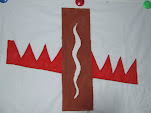A Hologram in Motion (6)
©
At the
time of death, the history of one’s life (really known only to one’s self and
God) freezes into a hologram. This hologram then becomes the plaything of
biographers if the deceased was an important enough personage to warrant
further public interest. If more than one biographies are written, then each
biographer is likely to make different associations between this or that past
event and the actions it influenced the biographed personage to engage in years
later.
On the
internet there are many examples of ‘frozen’ holograms. There are also examples
of moving holograms and bioholograms”: http://sangreality.weebly.com/helix-to-hologram.html
The latter are particularly interesting, because they hint at the possibility
that for all the killing that science and capitalism have helped expedite, it
has also opened a door to a better understanding of Life and Mind, which is
likely to be necessary in the near and medium distanced future as post-modern
man faces up to the damage that he has done to nature and himself.
Historian Edmund Burke III, brings a sense
of holography to history by taking ‘long duree’ history a step further and
transforming it into ‘big history’ https://www.youtube.com/watch?v=EHROAmkOZ-w
. The holographic perception of history is essential to, both, a better
understanding of societal traditions and culture as well as to world peace
outside the capitalist elite’s tendency to impose its views on the population
by force.
An excellent example of how to ignore an
old culture and devastate it in a very short time is my country of origin==Latvia Soviet Union and
the great hopes of the population to return to independence and all that this
implies, the mythical Ugly American, supported by Latvian exiles from WW2
times, was imposed as the model to strive for. In a very short time, the
Latvian political elites (often with extensive backgrounds as Soviet
apparatchiks) downloaded the capitalist model, fully aware that the imposition
of the model would come as a ‘shock’ to a populace acclimated to Soviet ways
for forty-six years or about two generations, yet despite this was aware of its
roots in ‘old’ history. The latter awareness was indeed what in the late 1980s
and early 1990s activated the Latvian drive for independence.
In this case the model for the Ugly
American was Harvard University ’s School of Economics
The results were what one could expect: the
country reeled. Former communist officials with experience and access to Soviet
institutions (= property) almost immediately formed rather large private
enterprises and in the name of democracy took control of political
institutions. Naturally, there was no call for revealing the names of the
persons who had previously taken their orders and done the will of Moscow
Strangely, the Latvian exiles and
descendants supported this ‘shocking’ of their countrymen or the countrymen of
their forebears in the name of ‘freedom and independence’. At the same time,
hardly anyone returned from America
The result of this idiocy as reform was
that over 300,000 Latvians (including emigrants from the former Soviet Union ), some say more, left the country and are
still leaving it. The total population once was over 2 million. Today the
population is closer to 1.5 million. In fact, one may say that the people of
the countryside were evicted from their domicile by the policies of the Latvian
government in collaboration with America ’s
interests to push successor governments of the Soviet
Union as much as possible to their knees. The result twenty three
years later is that according to a recent survey, about 20% of the population
more or less supports the government’s economic policies, while 80% see no
economic improvements following the 2008 financial and economic crisis that
was, for Latvians, a crisis on top of a crisis.
The divide between the Latvian people and
their government may roughly be measured by the above percentages. This 20/80%
split and the difficulty to sustain it in the face of a rapidly approaching
collapse of government and the economy was recently illustrated by the
government’s refusal to hold a referendum over whether the country was willing
to accept the euro over their own lats as future currency. This refusal was an
obvious governmental tour de force in using force to accomplish compliance with
the capitalist policies of Harvard, and U.S. (also NATO) strategy to repress
(in fact eliminate) the long duree or big history that was and remains ‘on the
mind’ of the country (this writer including).
Not surprisingly, the weapon of priority
for the government’s policy to remain in power has been to attack citizens of
Russian descent as a major factor that is sabotaging a more successful access
to prosperity. The Latvian media, too, largely corporate owned (no one knows
who the owners of the Latvian newspaper ‘Diena’ in Riga

No comments:
Post a Comment